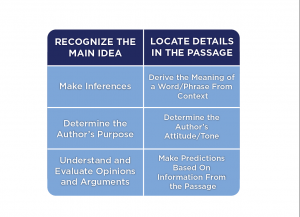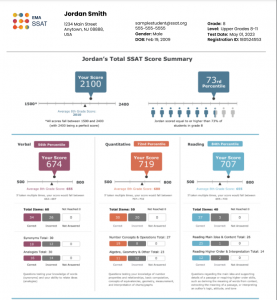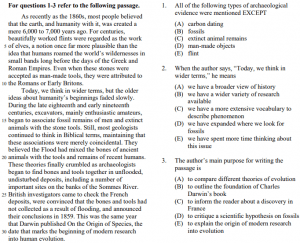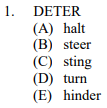
SSAT Exam Guide: All About the Upper Level SSAT
Welcome to the fourth part of MEK’s Exam Guide series, where we are covering all of the major exams we offer to provide you with a clearer understanding of each test’s parts, how they are scored, and set some baseline expectations. Our last post covered the entrance exam for the Bergen County Academies – a highly regarded public magnet school in New Jersey. In today’s article, we are going to broaden our sights by looking at one of the main private school entrance exams offered to students: the SSAT. Specifically, this guide covers the upper level of the exam, which is mainly used as a private high school admission test.
General Upper Level SSAT Exam Information
As stated above, the SSAT serves primarily as private high school admission tests for students currently in grades 8-11. The test generally tests a student’s ability to think and measures what they know from their prior years of schooling.
The SSAT has a relatively large number of sections, taking a total of 3 hours and 10 minutes. The exam provides students with a variety of options in how they take the exam, whether that be on paper, at home, or at a separate testing center. One important thing to note about the SSAT is that there are individual testing fees that start at a baseline of around $100 and can go as high as around $270.
For the SSAT, the timing of each section is as follows:
- Part 1 – Writing Sample – 25 minutes, 1 essay prompt
- Part 2 & 5 – Break – 10 minutes each
- Part 3 & 7 – Quantitative Math – 30 minutes each, 25 questions per section
- Part 4 – Reading Comprehension – 40 minutes, 40 questions
- Part 6 – Verbal – 30 minutes, 60 questions
- Part 8 – Experimental – 15 minutes, 16 questions
How the SSAT is Scored
The SSAT awards students one point for each correct answer, deducts a quarter of a point for each wrong answer, and provides no penalty for answers left unanswered. This allows students to make a decision on whether or not they should guess on a question they aren’t sure of or choose to leave the question blank.
The overall score for the SSAT will fall between 1500 and 2400. Each student’s score is also placed into a percentile comparison, not only for their overall score but also for each subsection within the test. The three sections that compose the SSAT are Verbal, Quantitative (Math), and Reading. Each section’s raw score is then scaled through a statistical method called “Equating”. In addition to these scores, students are also provided with a further breakdown of their performance along the different types of questions in each section.
The following is an example of an upper-level SSAT score report from the SSAT’s website.
The Differences Between Each SSAT Section
Now, we’ll take a closer look at each of the sections within the SSAT, understanding the differences in structure as well as providing some examples of questions from each part.
The Writing Sample
During the first section of the exam, students are given 25 minutes to write 1 essay. This is based on either a personal or general question prompt. This section is actually NOT scored, but still provided to schools that a student chooses to send their score report to. This is meant to help a school assess the student’s writing abilities without directly impacting their test score. These writing samples are obtainable for a separate fee as well.
The Quantitative Section
The third and seventh sections of the test are quantitative, testing a student’s math ability. Questions center around the areas of arithmetic, elementary algebra, geometry, and a few other basic concepts. Under the score report, questions in the quantitative section are reported as being either under the Number Concepts & Operations category or the Algebra, Geometry & Other category.
Unlike some other exams, students cannot use calculators on the math section. The following are some examples of math problems students might see on the exam.
The Reading Comprehension Section
The fourth section tests students on their reading comprehension through a few reading passages and questions that follow suit. This section measures a student’s reading ability and comprehension. Each of the passages range in length from 250 to 350 words and can be either narrative or argumentative.
These passages come from a variety of sources, including literary fiction, the humanities, science articles, or social studies topics. Questions cover a diverse set of topics as well, asking students to do a multitude of things as listed in the table below.

The following is an example of a reading passage and an associated question from the exam.
The Verbal Section
The sixth section is the verbal section, focusing on a student’s knowledge of vocabulary, verbal reasoning, and logical thinking. This section provides 30 synonym questions and 30 analogy questions for students to identify and interpret. Synonym questions ask you to choose the word with a similar meaning to the prompt word. Analogy questions ask students to complete the provided analogy with the correct option. Students have 30 minutes to complete these 60 questions.
The following is an example of what some synonym and analogy questions could look like.
The Experimental Section
The ISEE does NOT grade the experimental section. The purpose of this section is to test the quality of future SSAT questions. Thus, there is no need for students to worry about these questions for the sake of their test score and performance.
How Can You Begin to Prepare for the Upper Level SSAT?
After learning more about the SSAT, the next step is to determine whether this is the right test for you. Other than the SSAT, students also have the option of choosing the ISEE for their private high school admissions exam. Although this depends on whether the intended school accepts each exam, a majority of the most well-known schools do take both. We will be sharing more about the ISEE in our next part of the Exam Guide series.
For students in need of a SSAT prep class, MEK offers a variety of programs for students looking for professional and in-depth prep help for their admissions process.
- SSAT/ISEE Group Classes: This course serves to train 8th graders on how to ace the upper level SSAT and ISEE.
- SSAT/ISEE Private Tutoring: Students looking for more individualized instruction can opt for one-on-one tutoring throughout the year with expert instructors.
- SSAT/ISEE Prep 8: This class is similar to our group classes, but only offered in the summer to 8th graders that have already completed MEK’s Exam Prep 8 program.
If you are interested in learning more about our SSAT programs, please click here to visit our programs page. If you have any other questions or concerns, give us a call at +1 (855) 346-1410 or contact us today!








